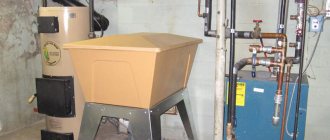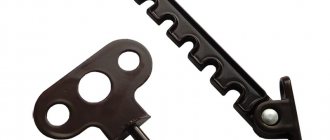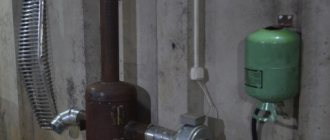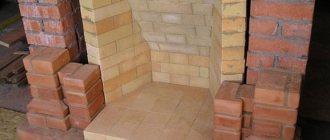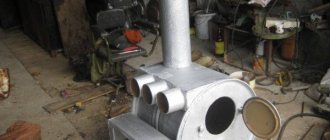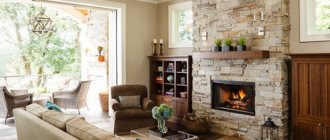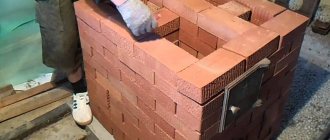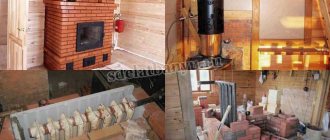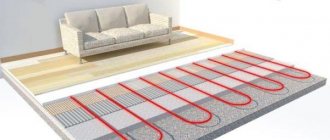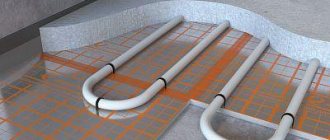Owners of private houses who decide to install a solid fuel heating boiler are primarily concerned with 3 parameters - the thermal power of the unit, its price and the duration of combustion from 1 load. These parameters are interrelated; the greater the power and duration of operation, the higher the cost of the heat generator. The only way to reduce costs is to make a long-burning boiler with your own hands or entrust the work to craftsmen. We present 2 designs of TT boilers, detailed drawings and the procedure for manufacturing heaters.
What is the real efficiency of solid fuel boilers
Manufacturers of heating equipment, in particular solid fuel boilers, offer a wide range of products with different characteristics.
Based on the design of the solid fuel boiler, all products can be divided into the following groups:
- traditional heating units;
- wood boilers with pyrolysis type of combustion (gas generator);
- long burning;
- pellet
A traditional solid fuel boiler, including a homemade one, in appearance resembles a stove or potbelly stove with the most necessary elements - a combustion chamber, a door, an ash pan and a chimney. Using the ash pan, you can regulate the draft by opening and closing the damper. Such designs are considered quite reliable because they do not contain any technological elements, such as temperature sensors or thermometers, an automatic control unit or electronics. In this case, the main design element of a solid fuel boiler is a heat exchanger that transfers thermal energy to the coolant. The heat exchanger can be tubular or made in the form of a container made of solid steel sheets.
There are, however, more complex devices that can also be classified as traditional. They are equipped with baffles and throttle valves to make it easier to regulate the draft, and the hot air travels a greater distance before exiting the chimney. Such partitions significantly increase the efficiency of the boiler, since more thermal energy is transferred to the coolant, and does not just “fly out into the chimney”. You need to understand that boiler efficiency is a very important indicator.
For such boilers, you can use almost any fuel - wood, coal, pellets and even garbage. The main thing is that it is as dry as possible. In terms of performance, boilers of simple designs can hardly claim 50% efficiency, and in most cases it is only 15-20%. The problem is that the fuel burns too quickly, without having time to transfer all the thermal energy to the water in the heat exchanger. As a result, more heat is simply released into the chimney or its excess causes the coolant to boil. For example, firewood needs to be added to the firebox every hour, and coal will last for 2-4 hours, but it still burns with excess energy and large heat losses.
Modern boilers with baffles and throttle valves are more economical and productive. In them, the combustion temperature of the fuel can be adjusted, and one load of fuel lasts for 8-12 hours. Therefore, the efficiency of such installations often reaches 80%.
Principle of operation
After loading and igniting the fuel, the flap is tightly closed. The fan pumps in oxygen, which stimulates the combustion process. When the set temperature is reached, the air flow stops. A minimal amount of oxygen passes through the natural ventilation system, which supports the smoldering process and prevents coal or firewood from extinguishing.
The sensors react to a decrease in temperature during cooling and, if necessary, send a signal to the automation to start the fan. The process is repeated.
In a homemade heater, the oxygen supply is manually regulated using a damper.
Boilers with pyrolysis combustion type
Pyrolysis boilers also use solid fuel, in particular firewood, however, the principle of their operation is fundamentally different from the installations described above. They are able to heat a house much longer and more efficiently, and use fuel more economically. In this regard, the cost of such units is approximately 1.5-2 times more than others.
The secret of gas generator (pyrolysis) boilers is that under the influence of high temperature and lack of air, wood is converted into charcoal, releasing pyrolysis gas.
This reaction requires a temperature between 200℃ and 800℃. This releases a large amount of energy, which dries the wood and heats the air. Pyrolysis gas moves through pipes into the combustion chamber, where it ignites when mixed with air - this is how most of the heat is generated.
Active carbons participate in oxidative processes during the combustion of pyrolysis gas, so the smoke coming out of the chimney consists mainly of carbon dioxide and steam - the content of harmful components is negligible. In addition, pyrolysis boilers, in principle, emit much less smoke than classic installations. Since the fuel burns with virtually no residue, gas generator boilers require cleaning quite rarely.
It is worth noting that a fairly high combustion temperature can be achieved even with raw firewood, however, in this case, the boiler’s performance will drop almost by half, which means fuel consumption will increase by the same amount.
Thanks to automation, the combustion intensity in such a boiler can be adjusted to save fuel and create an optimal temperature in the room.
Please note that making a pyrolysis heating boiler using solid fuel with your own hands is quite difficult and very dangerous. In the event of assembly errors, such an installation may explode.
What you will need
When a project is selected, it is necessary to calculate how much material is required. If the instructions suggest that you need cast iron, do not buy cheaper aluminum, otherwise the device will quickly fail. It is better to purchase a thermostat and deflector ready-made than to make it yourself.
It is important to consider several points when making the device:
- It is advisable to choose a programmable thermostat, so you can set a controlled temperature.
- It is better to install the deflector above the chimney pipe, thereby ensuring exhaust. It may look like an umbrella with a cone. The material is only stainless steel.
- The device must have automation, which includes control over flame, overheating, and draft. The presence of a blast valve is also important.
Long burning fuel units
The idea of creating long-burning solid fuel boilers with your own hands will certainly seem attractive to many. The beauty of such structures is that you only need to put firewood in them a couple of times a day. A long-burning boiler differs from a traditional unit in that combustion in it begins from the top of the fuel stack. In this case, air is also supplied to the fuel chamber from above.
The design of a long-burning solid fuel boiler assumes the presence of a water circuit around its body, so the water in it is heated efficiently at any stage of the process. Since when the boiler is operating, it is not the entire filling that burns at once, but only the top layer of fuel, it lasts for almost 30 hours. A number of universal solid fuel boilers when using coal can operate for up to 7 days on one fill.
This design is not structurally complex and does not have any precision instruments that need to be connected to electricity. Therefore, their price is quite acceptable for the consumer. In addition, it is quite possible for a home craftsman to assemble a solid fuel boiler using ready-made drawings with his own hands. You can make a heating boiler with your own hands and save a lot of money.
Here are a few disadvantages of these designs. Fuel cannot be added to a boiler that is running. Firewood for the boiler must be well dried (no more than 20% humidity) and cut into small logs. Coal can only be used of high quality, with a low slag content. In addition, units of this type are limited in power - as a rule, no more than 40 kW.
Another type of solid fuel boiler is pellet units. Their difference is that wood waste pellets are used as fuel. Most industrial models have a special hopper from which granules are automatically fed into the firebox.
Types of devices and their characteristics
Heaters are of the following types:
- Classic. Oxygen is pumped into the furnace using a fan. This allows you to regulate the intensity of heat production.
- Top burning. Characterized by lower efficiency. A special feature is the large firebox, in which the combustion of raw materials occurs from top to bottom. In this case, the heat load is distributed evenly, but the water heats up slowly.
- Pyrolysis. Characterized by high efficiency. Energy is generated not by burning fuel, but by smoldering gas. It continues to burn in another compartment, providing long-term heating.
- Mine. The combustion chamber is arranged vertically and occupies half the area. Combustion of raw materials starts from the bottom. The upper layers of coal gradually sink, mixing with ash, which ensures slow smoldering.
Cast iron and steel structures - what are the differences?
Whatever material the boiler is made of, it is very important that it meets the basic operational characteristics. Let's look at them in more detail.
First of all, you should pay attention to the material of the heat exchanger - cast iron or steel. If you want to use a ready-made solid fuel boiler design, it’s unlikely that you’ll be able to make a cast iron heat exchanger yourself. Such work requires both special equipment and special knowledge and skills. Therefore, you can purchase ready-made sectional structures, which are disassembled before transportation and reassembled on site.
Cast iron heat exchangers tend to become covered with dry rust - a special film that protects the walls of the unit from destruction. In addition, wet rust also forms much more slowly, which is due to the long service life of cast iron products - from 10 to 25 years. Other advantages of cast iron heat exchangers include the absence of the need for frequent and complex maintenance. Cleaning of such devices is rarely required, and carbon deposits practically do not reduce the efficiency of the boiler. If it is necessary to repair or increase the power of the unit, you only need to replace the defective sections or increase their number.
The disadvantages of cast iron products are:
- the large mass of the boiler requires a separate foundation;
- difficulties in the assembly process and high transportation costs;
- sensitivity to thermal shock - cast iron does not like temperature changes, so contact of a hot surface with cold firewood or cold water can be detrimental to it;
- high thermal inertia - it takes a long time to warm up the boiler, but its subsequent cooling occurs slowly.
As for steel products, they are less sensitive to temperature changes and are not afraid of contact with cold objects. This property allows, when assembling solid fuel heating boilers according to drawings, to equip them with sensitive automatic elements. And thanks to their low inertia, such units quickly warm up and cool down - this allows you to regulate the air temperature in the house. At the same time, you can make a drawing of a long-burning solid fuel boiler with your own hands, which will allow you to take into account all the nuances.
In appearance, steel boilers are solid welded units that are quite difficult to transport, although their sensitivity to mechanical damage is much lower than their cast iron counterparts.
The possibility of repairing steel boilers is, from the point of view of some experts, very doubtful. Repairing, as well as welding a boiler with your own hands according to a drawing at home, is quite difficult; over time, leaks may form at the seams in it. In fairness, we note that everything depends on the worker’s skills in working with a welding machine. But repairing a cast iron heat exchanger is still easier - you only need to replace the sections.
As a rule, boilers with cast iron heat exchangers are non-volatile and inexpensive, so they can be a worthy alternative to already installed heating equipment in the event of a power outage. Coolant circulation in such units occurs naturally, without the use of a pump. However, the batteries must be installed in such a way that when heated, water moves freely through the pipes under the influence of pressure in the boiler.
Advantages and disadvantages of the device
Advantages of solid fuel equipment:
- high efficiency (90%);
- economical coal consumption;
- reliability;
- availability, interchangeability of fuel;
- unpretentiousness to the quality of raw materials;
- autonomous work.
In the future, the device can be further developed and improved to increase productivity and automate processes. And if you assemble it yourself, you can save money, because the cost of materials is much lower than the average market price of the finished structure.
Flaws:
- large dimensions;
- the need to comply with the requirements for the organization of the boiler room;
- complex device;
- regular maintenance.
Assembling a boiler according to a finished project
The easiest way would be to build a solid fuel boiler out of brick with your own hands. Its design is popular and does not require complex calculations. Such a boiler can be used for several purposes at once, which is why they are installed mainly in kitchens. It is noteworthy that even beginners can assemble such a unit on their own.
In the process of work, you will need a grinder, a welding machine with electrodes, sheet steel, brick, materials for stove mortar, pipes and metal corners. For those who have never held welding in their hands, it is best to cut the parts according to the drawing of a solid fuel boiler, and entrust the welding work to a professional. This is important, since the quality of the seams directly affects the durability of the boiler.
The positive aspect of independent construction of heating equipment is that you can select the size of the solid fuel boiler and firebox, as well as calculate its power for specific needs. In addition, it can be equipped with a hob or brick vault so that heat is accumulated during the combustion of wood and then redistributed to the heating system.
The heat exchanger is most often made rectangular, using a rectangular profile and pipes with a cross-section of 40-50 mm. Thanks to the profiles, the joining of pipes is easier, and the seams are more durable.
A little about DHW circuits
Due to their characteristics, any solid fuel heaters are poorly suited for direct heating of water for domestic hot water needs. Nevertheless, some manufacturers still integrate a second circuit in the form of a coil into their products. At the same time, the design of double-circuit solid fuel boilers can be different; the coil can be located inside the water jacket and heated by the coolant. In other models it is placed inside the firebox or above it.
The best option is not to place a heat exchanger inside a wood-burning heat generator, but to prepare water in an indirectly heated boiler, which will also serve as a heat accumulator. But not everyone can afford to purchase such equipment, so users are still interested in dual-circuit units, although they are unlikely to be able to provide all the needs for hot water. Below is a diagram of installing a boiler with a function of heating water for domestic hot water:
Step-by-step instructions for building a solid fuel boiler
So, the whole process of how to make a boiler with your own hands according to the drawings can be divided into several successive stages:
- Using a grinder, you need to cut blanks from pipes and profiles. The profiles will be racks; you need to cut round holes in them with a gas cutter for joining with the pipes. You will need to make 4 holes along the Ø50 mm pipe in the front pillars and the same number in the rear ones. In addition, we also need holes for inserting into the heating system. Sagging and deposits as a result of cutting or welding must be cleaned with a grinder so that they do not interfere with the movement of water through the pipes.
- Next, the blanks are assembled into a single structure. Two people will have to work - the welder will need an assistant to hold the tubes in a stationary position. To make it more convenient, you can place the racks with pipes on a flat surface and weld the front and back parts of the boiler.
- Now you need to ensure the supply and drainage of water from the boiler. The incoming and return pipes are welded to the finished frame, and the ends of the rectangular profiles are welded with pieces of metal 60x40 mm.
- Before installing the heat exchanger, it is checked for leaks. To do this, install it vertically, close the bottom hole and fill it with water. If there are no leaks at the seams, then you can continue working.
- The boiler body is built from brick and a heat exchanger is built into it, leaving a gap of at least 1 cm between them. The register must be installed in such a way as to create a rise towards the exiting hot water. The level difference between the outlet and the front right upper corner of the heat exchanger must be at least 1 cm. This will improve coolant circulation and eliminate air pockets.
- The brickwork should overlap the heat exchanger from above by 3-4 cm. A cast-iron slab is laid on top of the masonry. The chimney is installed at the discretion of the owners - brick, metal, or led into a ready-made pipe.
Possible problems during construction and operation and their elimination
The heater must be installed on a concrete screed. Due to heavy load, another type of coating may sag and connections may be damaged. It is better to buy doors for the fuel and ash compartments. Homemade designs do not allow for tightness, which leads to incomplete combustion of raw materials, decreased productivity and a possible fire due to coal falling out through the cracks.
To ensure circulation of the coolant, you need to install a pump. To increase the service life of the equipment, it should be mounted on a return pipe.
The chimney must be equipped with a damper. When closed, it prevents hot air from escaping, i.e., it reduces heat loss, slows down the smoldering process and increases heating time.
How to increase boiler performance
A self-assembled solid fuel boiler, as a rule, is characterized by significant heat losses associated with the loss of heat into the chimney. Moreover, the straighter and higher the chimney, the more heat is lost. The way out in this case would be to create a so-called heating panel, that is, a curved chimney that allows more thermal energy to be transferred to the brickwork. The brick, in turn, will give off heat to the air in the room, heating it. Often such passages are arranged in the walls between rooms. However, this approach is only feasible if the boiler is located in the basement or on the ground floor, or if a bulky multi-stage chimney is built.
Alternatively, you can increase the efficiency of the boiler by installing a water heater around the chimney. In this case, the heat of the flue gases will heat the walls of the chimney and be transferred to the water. For these purposes, the chimney can be made from a thinner pipe, which is built into a pipe of a larger cross-section.
The most effective way to increase the efficiency of a solid fuel boiler is to install a circulation pump that forcibly pumps water. This will increase the productivity of the installation by approximately 20-30%.
Of course, the boiler must be designed so that the coolant can circulate independently if the electricity in the house is turned off. And if it is available, the pump will speed up the heating of the house to comfortable temperatures.
Electricity and gas as traditional fuels
Electricity is the most accessible form of energy, in the sense that there are very few areas left that are not electrified. Prices for electrical energy make us think hard about how advisable it is to make it the main type of fuel. Although modern electric boilers allow you to save a lot and you can choose the most optimal tariff, the quality of electricity supplied to our homes leaves much to be desired, and interruptions and instability of supply can make us freeze “without light” for weeks.
Natural gas can also be considered relatively affordable, but its problems are the same as those of electricity - unstable supply, disgusting quality, low pressure and high prices. Not a single human gas boiler will operate on such fuel for a long time, and repairing gas equipment is a long and very expensive matter. Therefore, you definitely cannot trust gas to heat your home.
